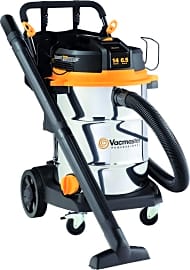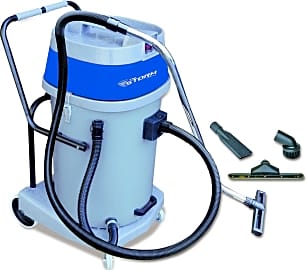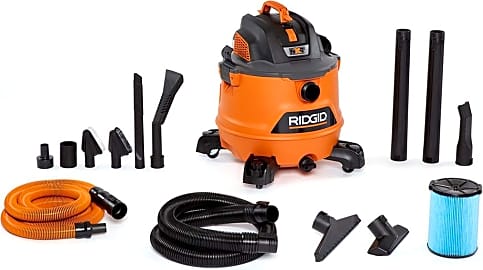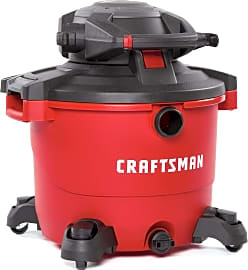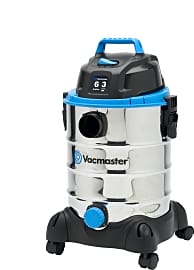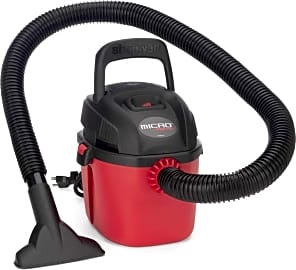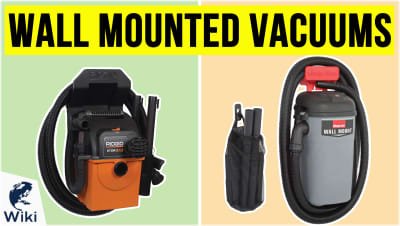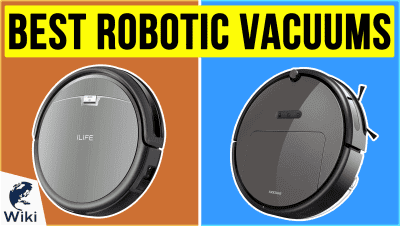The 10 Best Wet Dry Vacuums

This wiki has been updated 39 times since it was first published in April of 2015. Sometimes you do want something that sucks, specifically when you have a daunting mess to deal with. These wet/dry vacuums plug into standard 110-volt outlets and take care of both dirt and liquids efficiently. Some can also reverse their power to act as blowers. They can make cleaning up your house, garage, workshop or yard a much simpler task than it would be otherwise. When users buy our independently chosen editorial selections, we may earn commissions to help fund the Wiki.
Editor's Notes
December 02, 2020:
During this update, we focused on two things. We wanted to increase the versatility in the offerings so that every user could find one right for their needs, and we made sure to include some of the most recent models from companies so there wouldn't be availability issues.
With the above priorities in mind, we added the Shop-Vac Micro. Previously, the only handheld model we had was the DeWalt Max DCV581H, which is more powerful and has a more rugged overall build, however the Shop-Vac Micro is more affordable and is smaller in size. The DeWalt Max DCV581H has a two-gallon tank, whereas the Shop-Vac Micro has a one-gallon tank, which means it may be a better choice for homes with very little space to spare for tools.
We also added the Vacmaster Beast, which took the place of the Workshop Cleaner, our previously-recommended large-capacity steel tank model. While there was nothing inherently wrong with the Workshop Cleaner, we just feel that users will appreciate the padded handle of the Vacmaster Beast, especially when the 16-gallon tank is filled to the brim with water. Other than that difference, they both have essentially the same specs and equally reliable motors.
The DeWalt DXV09P was included this time around because we didn't have any other 9-gallon models on the list. Previously, our recommendations jumped from those with 6-gallon tanks to those with 12-gallon tanks, which we felt was a bit too large of a spread. As with all of the company's power tools, the DeWalt DXV09P can stand up to serious use day after day.
December 15, 2019:
Wet/dry vacs are remarkably useful tools, whether you're working at a professional construction site or in the comfort of your own home workshop. Vacmaster makes a couple very good yet relatively inexpensive models; the Vacmaster VBV is especially portable and the Vacmaster VQ607SFD is quite large and durable, but it's also very heavy. The Shop-Vac EZ, made by the company whose name is now ubiquitous with these versatile tools, is another highly affordable choice that can get a lot done. In fact, it comes with a gulper nozzle designed specifically to draw in large amounts of fluid at once.
In the middle of the pack, price-wise, and the best options for medium-duty work, are the Ridgid WD1270 and Ridgid WD1450. They're both pretty similar; the main difference is the 12- versus 16-gallon tank as well as the overall weight of the units. At 18 pounds, the WD1270 is quite easy to move around, but the larger WD1450 is still a great choice if you need the extra capacity.
If large messes are commonplace where you live or work, there are plenty of great options, but they will cost you quite a bit more. The Karcher Multi-Purpose has a powerful 1,800-watt motor and an automatic filter cleaning function, though it doesn't, of course, entirely eliminate the need for manual cleaning and replacement of the filter. The Craftsman XSP is easy to empty and maintain and has a durable top-mounted handle that makes it also pretty easy to lug around. The Workshop Cleaner and Mercury Storm, meanwhile, are suited to near-constant use, and feature incredibly large tanks as well as sturdy, never-flat wheels, making them great for use on construction sites, but a bit cumbersome if they need to be used on different floors.
A Brief History Of Wet Dry Vacuums
Pairing the rolling brush of carpet sweepers with vacuum suction technology, Spangler's prototype collected dust in a pillow case.
Wet dry vacuums are a special use variation of the standard vacuum, a device with roots way back in the late 19th century.
The earliest ancestor of the device wasn't a vacuum cleaner at all, but a mechanical cleaning tool called the carpet sweeper. Based on an 1876 patent by Melville R. Bissell, these sweepers featured a box containing rollers and brushes that scraped up dust and pulled it inside. Today, Bissell's company is one of the largest manufacturers of vacuum cleaners in the world.
By 1900, powered cleaners were introduced. Most early powered cleaners actually pushed air, rather than pulling air into a collector. One such powered cleaner relied on an internal combustion engine, and could only be moved by horse-drawn wagon. Because of their impracticality, these cumbersome cleaners were typically only used by businesses.
Just a year later, in 1901, powered suction vacuum cleaners were invented independently by American inventor David T. Kenney and British engineer Hubert Cecil Booth. Booth is credited with originating the phrase "vacuum cleaner" to describe his creation. Booth's vacuum was powered by an enormous horse-drawn engine, and Kenney's by a two-ton steam engine.
Finally, in 1905, British manufacturer Walter Griffiths revealed "Griffith's Improved Vacuum Apparatus for Removing Dust from Carpets" — the first vacuum cleaner for domestic use. Although this portable model required the user to squeeze a bellows to suck up dust, it was easily operated by an individual, unlike its predecessors. Griffiths' vacuum was also easy to store and clean, unlike competing models from the era, which used water to separate collected dirt and debris.
The first portable electric vacuum cleaner was invented by Canton, Ohio department store janitor James Murray Spangler in 1907. Pairing the rolling brush of carpet sweepers with vacuum suction technology, Spangler's prototype collected dust in a pillow case. After trying and failing to market the invention himself, Spangler sold the patent to leather goods manufacturer William Henry Hoover. For this reason, it is Hoover, not Spangler, whose name is synonymous with the vacuum cleaner.
The Hoover Company's first vacuum — the Model O — was rolled out in 1908. The company continued improving Spangler's design in the early 20th century, releasing disposable filter bags in 1920, and the upright vacuum cleaner in 1926.
With the post-World War II baby boom, vacuums became a staple of American life. As the market grew, companies expanded their investment in vacuum technology, and cleaners grew more effective and durable as the century wore on.
Today's wet dry vacuums combine powerful suction with the ability to handle liquids seen in early commercial models, and thanks to innovations like the reverse-flow switch, they are significantly easier to clean.
The Ins And Outs Of Vacuum Cleaner Technology
The substantial suction modern wet dry vacuum cleaners wield is generated when the pressure outside the cleaner is greater than the pressure inside. This effect occurs when an electric fan reduces pressure inside the cleaner, effectively pulling debris into a dust collector.
Prior to 1910, many vacuums used water to filter debris from the air, a method that required intensive maintenance to prevent the growth of bacteria and mold.
Many standard vacuum cleaners collect debris in a disposable bag.
Unlike those primitive models, today's cleaners don't require water, and instead rely on filters to clean the air as it passes through. Filters are integral to vacuum safety because vacuums pull potentially harmful dust up from the ground and into the air. Central vacuum systems, which vent dirty air outside the space being cleaned, are sometimes used in office and apartment buildings that require frequent cleaning because of their safety in this regard.
With a high-quality filter and proper vacuum care, even standard cleaners cause little need to worry. Today's filters are so well designed they are even effective in eliminating fleas, killing 96 percent of adults.
Most wet dry vacuum cleaners store the dirt and liquids they collect inside a reusable compartment. Found in the drum, this compartment is, by design, easily to empty and clean.
Many standard vacuum cleaners collect debris in a disposable bag. Made of an air-permeable fabric or heavy paper, these bags filter out all but the finest particles.
Other standard vacuums are bagless, featuring filtered containers that can detach and be emptied when necessary. Some bagless vacuums utilize an alternative method called cyclonic separation, which rapidly spins incoming debris, forcing it inside a collection bin.
The Many Shapes Of Vacuum Cleaners
To most Americans, a vacuum cleaner sits upright, with a suction base that pulls dust into a vertical bag. While popular in the United States, this model is uncommon in Europe, which favors an alternative design.
Wet dry vacuums are designed to intake dry and wet debris alike, and sometimes feature reverse flow functionality, making it easy to clear clogs and clean the hose.
The most common vacuum design in Europe is the canister, which separates the dust collector from the motor. Canister models have a flexible hose and more maneuverability than their upright counterparts. For this reason, most wet dry vacuums come in a commercial-grade canister configuration known as the drum model.
Wet dry vacuums are designed to intake dry and wet debris alike, and sometimes feature reverse flow functionality, making it easy to clear clogs and clean the hose.
A variation on the wet dry model is the compressed air-powered pneumatic vacuum. Frequently used in industry, it can hold up to 50 gallons of liquid.
Among the newest designs is the robotic cleaner, which automates the cleaning process, and uses onboard processors and scanning technology to map the surrounding space.
Other designs include a portable cyclonic vacuum pioneered by James Dyson, the central vacuum system popular in city high-rises, and the vacuum truck, which features a massive cleaner attached to a vehicle.



